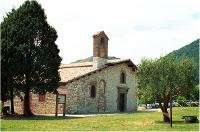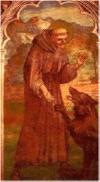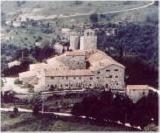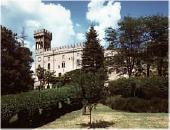Gubbio -
Excursions Outside Gubbio
After visiting the town centre, a series of other important monuments can be visited along the three main roads that lead away from Gubbio.
 |
| Chiesa di Santa Maria della Vittoria |
 |
| San Francesco e il Lupo |
Via della Piaggiola continues into Via Frate Lupo, where there is the church of Santa Maria della Vittoria. Legend has it that when St Francis stayed in the convent here he met a wolf in the nearby wood that he managed to tame only with his words.
 |
| Abbazia di S. Verecondo o Vallingegno |
The second road out of Gubbio leads towards Umbertide. The convent of San Secondo stands directly outside the city walls and was once the headquarters of the administration that controlled church lands in the Ravenna and Gubbio areas. During the period from 568 to 772, after the fall of the Roman Empire, the 'Byzantine Corridor' of church lands was the only remaining safe passage from Christian Rome to Byzantium. Previously a building had been erected here on the remains of a Roman temple. The last in a long series of alterations was carried out in the 15th century. The fake trilobate arches on the exterior of the apse are 18th century, while the 14th century interior is Gothic in style. With its re-used Roman columns, the Chiostro dei Canonici is also interesting. The Pamphili chapel in the nearby cemetary also belongs to the monastery and is entirely frescoed by Giovanni Beda di Benedetto (1457) with 'Stories of St Sebastian'. The surface of the altar bears the date 1134, even though the decorative motifs are 7th-8th century.
At Madonna del Ponte, 2 km from Gubbio, stands a little Romanesque church built around 1200, an early example of ogival arch construction whose interior was modified in the 18th century.
At Mocaiana a short detour to Loreto leads to Pieve di San Giovanni Battista. Built in the 12th century, a simple facade is broken only by an acute Gothic doorway. The crypt, which is accessible from the exterior, is particularly interesting.
Back on the road to Umbertide, at Val d‘Assino on the crossroads for Pietralunga, stands the castle of Carbonara, one of the best preserved castles in the surrounding area, built to initial designs in the 12th century. At Camporeggiano there is the abbey of San Bartolomeo, founded in 1067. The three-nave interior is subdivided by broad arches that rest on square pilasters. The flight of steps that leads to the raised presbytery is not original, while the apse is probably later than the rest of the building. Beneath the presbytery, the crypt is composed of three narrow apses. The columns that support the ceiling have been taken from earlier buildings and are surmounted by unusual 11th century inverted pyramic capitols.
Lastly, the third road, leads to Gualdo Tadino. Aftter the village of Padule stands the d’Alfiolo castle, built by the d’Alfiolo counts in the 11th century and successively transformed into a Benedictine abbey at the end of the 12th century. This later use of the building has lent it its alternative name of “Badia”. A fine 1224 plant motif decorative frieze with animal and human figures has been incorporated into the facade of the building. Originally it decorated the portal of the church but was walled up when the direction of the building was turned. In 1539 the bishop of Gubbio, the future Pope Marcellus II, adopted the building as his residence. He paved the church with the fine terracotta flooring we see today, and added the tree shaped well head in the cloister in 1536. Marcellus' successors completed the work he had started by transforming the abbey into a late-Renaissance style residence. Currently the structure is used as a country house bed & breakfast.
 |
| Castello Torre dei Calzolari |
© Copyright 2001-2025
by Umbriaonline.com
SCG Business Consulting S.a.s. di Giacomelli E. & C. - Internet Advertising Division - © 2001-2025 All Rights Reserved - P.IVA 01675690562